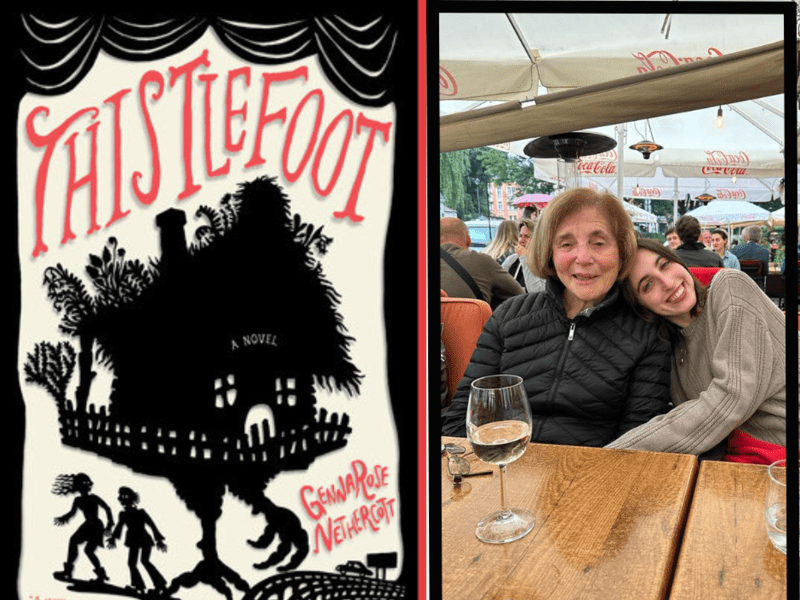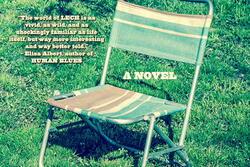Review: "Thistlefoot" by GennaRose Nethercott
(Spoilers ahead!)
Like many Northeastern Jews, some of my earliest childhood memories take place in Florida. My grandma kept boxes of toys and books that she lugged out into the living room each year at Christmastime when my family would fly down to visit her. There was a picture book—if only I could remember the name!—about a poor Jewish family living in a shtetl. It was not graphic visually or thematically, yet something about it absolutely terrified me. At night, I would pore over its pages and work myself into a frightened frenzy. I crept around my grandma’s dark living room, heart sputtering, fearing that the shtetl family’s ghosts were following me and might drag me to the underworld before I made it safely to my pull-out bed. I had nightmares. My mother, bleary-eyed, hugged me when I ran to her bedroom door crying at odd hours of the night.
Recently, I took a trip with my mother’s side of my family to Poland, where I read Thistlefoot by GennaRose Nethercott. Traveling and reading helped me understand those shtetl spirits that roamed my grandma’s house, as well as other souls that have haunted me, for better or worse.
Thistlefoot is the name of the magical shtetl house with chicken legs at the heart of Nethercott’s fantasy novel. The house unexpectedly travels to estranged siblings, Bellatine and Isaac Yaga, who are descended from the mystical, Russian-Jewish matriarch Baba Yaga and her two daughters. Being in the house and learning its history enables Bellatine and Isaac to connect with each other, their ancestors, and their Jewish heritage. It’s an ambitious concept to be sure, but Nethercott pulls it off with maximalist, lyrical prose, and inventive and often metaphorical narrative structures.
Thistlefoot and the Yaga siblings are on the run from an evil being, the Longshadow Man, who is the manifestation of the hateful pogrom that killed some of the house’s original inhabitants. (I know, I know, but stick with me here.) He seeks to destroy Thistlefoot in order to fully erase the memory of the persecuted shtetl Jews and the Yaga family bloodline.
This world is a fantastical one indeed—Isaac has the ability to shapeshift and take on others’ identities, and Bellatine can wake the dead and other inanimate objects. These powers, which initially terrify the siblings, eventually allow them to defeat the Longshadow Man and keep alive the memories of their ancestors. At the climax of the book, Bellatine awakens puppets who tell the story of the destroyed shtetl, and Isaac shapeshifts to become different dead people from the shtetl. The sheer force of these spoken and felt memories vanquishes the Longshadow Man, and even though the house is burned down, the Yaga siblings honor the lives of their ancestors through the freedom, love, and sense of community they now find on their own. It is through storytelling and remembrance that the siblings find salvation. Here, ghosts of the past may sometimes be difficult to confront, but feeling them and telling their stories is necessary for a more loving, meaningful world.
On my family trip throughout Poland—where many of my Ashkenazi ancestors hail from, where many of them fled from pogroms and antisemitism, and where the Holocaust destroyed much of what was left of their world—I painfully and joyfully felt each page of Thistlefoot. Baba Yaga’s magical, fierce matriarchal instinct—the urge to protect her daughters from any and all dangers—resonated with a group of all women (save my uncle) of varying ages. We visited sites in Warsaw, Kielce, and Krakow where Jews once lived, suffered, flourished, gave birth, and died all the same.
Instead of being merely afraid of these ghosts, I sought to understand and feel the spirits of these people, of my family from not so long ago, as I held close my living family. I hugged my grandma, tears in our eyes, as we flipped through books at Auschwitz containing names of people, many of whom share our family names, killed in the Holocaust. On other days, I spoke Yiddish with my aunt, doing a bad but delightful job translating inscriptions on statues and in museum exhibits. I walked through medieval cities with my mother and laughed as we dribbled ice cream on our chests and shopped for souvenirs. I even had Shabbat dinner at the Krakow JCC, where the Jewish community is miraculously rebuilding itself.
As Thistlefoot puts forth, homes are frequently ridden with spirits. Nethercott writes, “Every house that’s ever been lived in is haunted. Haunted with births and feasts, with piano notes, with arguments, with promises kept and unkept… All the makings of a life.” In the places I’ve inhabited, I feel both the absence and presence of my friends and family members who have died. Their stories hover around me like a thin, spidery shawl. I’ve found other, more abstract types of ghosts, too. Ghosts of former selves, of a childhood gone, of friendships grown distant, families changed. Recalling these memories can be excruciating. And there are the joyful ghosts—ghosts of birthday parties, of papers written and books read, of relationships forming and deepening, of families and faiths that continue surviving despite so much hardship.
Thistlefoot eventually posits that ghosts aren’t tethered to a setting, person, or era. At the end of the novel, the destroyed house itself narrates to the reader: “What, are you surprised to hear me still speaking? If so, you have not been paying attention. A house can be burned. A story cannot. What is a house but a container for a life? What is a life but a container for a story? When a container is broken, it does not destroy the contents. It sets them free.” Life and death, ultimately, are two sides of the same coin. What matters in the end is incorporating these ghosts into our lives, in all of their radiance and pain and complexity.
I am no mystic, and in my day-to-day life, my more fantastical beliefs are buried deep within my pragmatic self. But these days, when I think of younger Abby’s fear of ghosts in my grandma’s house, or of people and times that have gone from this realm, I also think of a magical, chicken-legged cottage. In Poland with my family, at home in Brooklyn and Boston, or wherever I may go next, I’m now trying to embrace the spirits around me. I know that confronting the past and telling its stories is difficult, heavy, beautiful labor. Doing so is the thing that keeps me, and all of us, alive.








thanks for sharing an interesting post, this information was the price, I read it while the service wrote <a href="https://www.nursingpaper.com/">writing papers</a> in mwdy place, awdnd I reswdted.
Thank you for sharing this essay. I was not aware of the book but now I'll be picking up a copy to read! I can visualize your family's visit to Poland and feel like I was there with you. Shalom to you and all your family!
This is a brilliant article, it exposes the fact that we are all
defined by our past, often unaware of the effects it
has and will continue to have on our lives. Your awareness of this while still being so young is amazing to me!! Your writing is so beautiful and I loved reading
this wonderful essay!
Thanks for sharing!!
Margie Feinberg